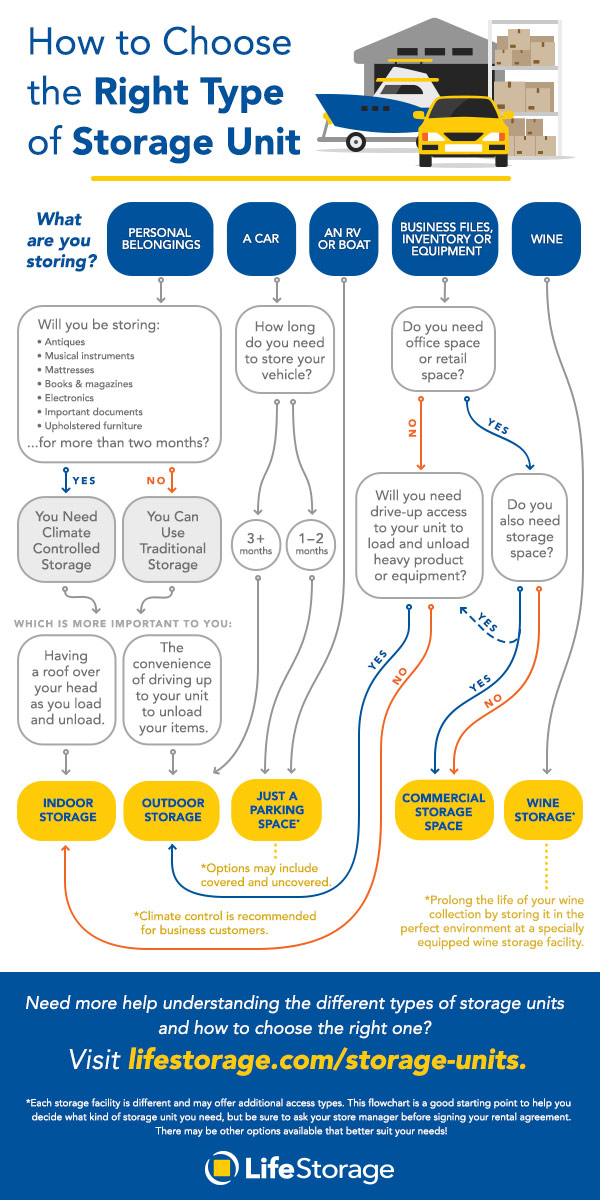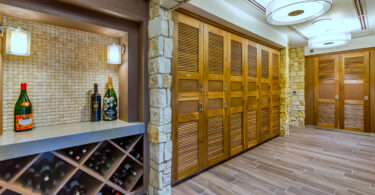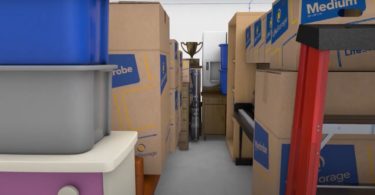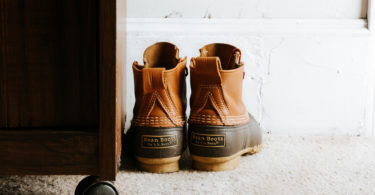Whether you need extra storage in between a move, a place to keep that sweet DeLorean while you rebuild it or simply a safe space for your hobby, storage units provide the perfect answer to your need for a little extra space – as long as you pick the right one.
Problem is, when you drive along the freeway, staring at those neatly marching rows of storage units from the fast lane, they all look pretty much the same … but they’re not.
From indoor and outdoor units to climate-controlled areas to specialty storage types, there are a lot of different storage unit types. Before you hop on the phone or go on an all-out Googling spree, it’s helpful to know which factors to keep in mind during your search.
Here are a few of the most important considerations for how to choose a storage unit, followed by a handy flowchart to easily get you your answer.
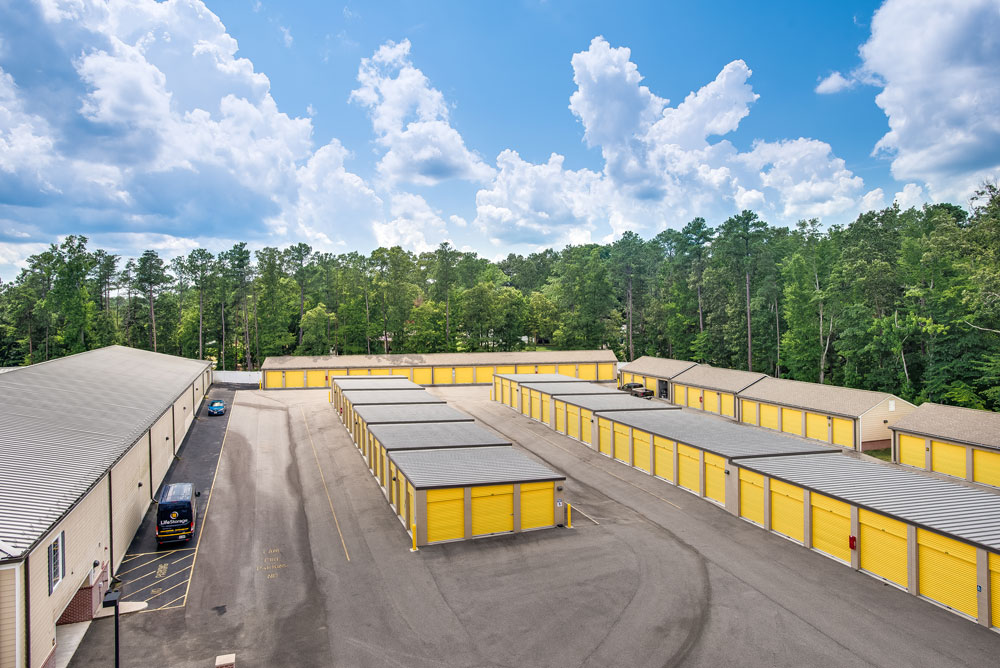
Different Types of Storage Units Explained
Indoor Storage Units vs. Outdoor Storage Units
Many people are confused about the difference between indoor and outdoor storage units, thinking perhaps that an outdoor storage unit doesn’t have a door. In reality, the main difference between indoor and outdoor is where the door is located.
With indoor storage units, you first enter a building and then walk down the hall to your unit. With the outdoor version, the building still contains multiple units, but you can open yours up from the outside.

The Benefits of an Outdoor Storage Unit
An outdoor unit offers the significant benefit of drive-up access storage – the ability to drive right up to the door of your storage unit. That way, you don’t have to make another trip from your car to the door of the building to the unit itself – convenient and ergonomic. This will certainly save you money on moving day if you have movers who charge by the hour — which most of them do.
The Benefits of an Indoor Storage Unit
The main benefit of an indoor unit is that weather is never an issue. Need to reorganize your unit? You’ll have a roof over your head each time. Never worry about sand and dust getting EVERYWHERE if you’re in an arid climate, or getting snowed on in if you live in Life Storage’s hometown of Buffalo.
Likewise, your belongings are less susceptible to the outdoor elements each time you open your unit if you’re indoors. You have an added layer of protect between your stuff and pests, water and all the above.
Insider’s Tip: All indoor units are climate controlled in some form and less susceptible to the climate–just like your belongings inside.The main reason a storage facility builds indoor units is because they are more energy efficient and less costly to maintain. If you’re comparing an indoor climate controlled unit to an outdoor climate controlled unit, the indoor unit will almost always be cheaper to rent.
And if you don’t mind using elevators, you just might find that units on the upper floors are less expensive than ground floor spaces, too.
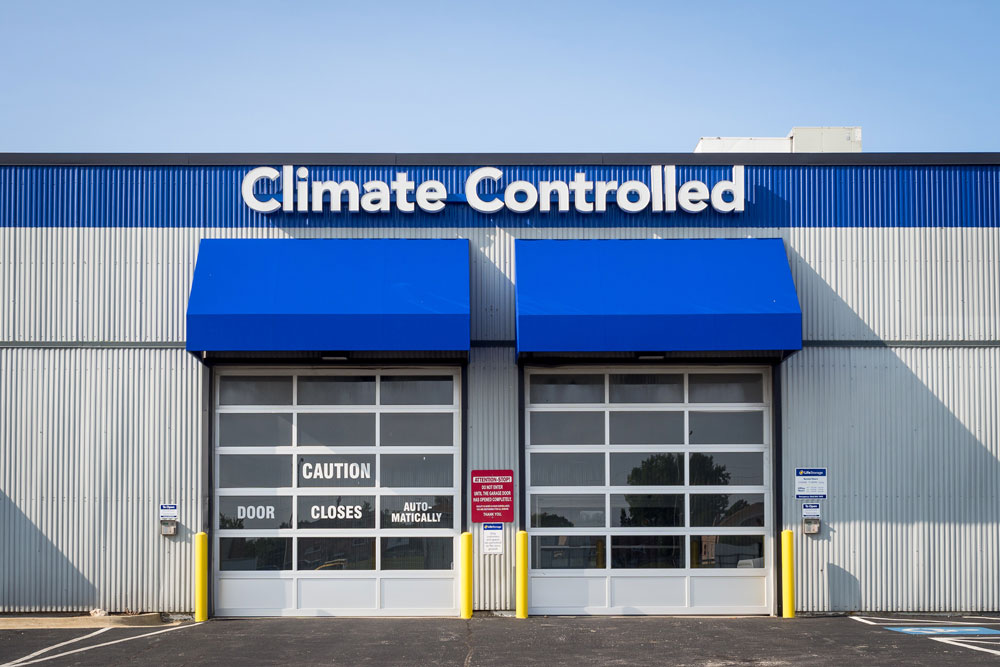
Climate Controlled Storage Units
Whether or not you need climate-controlled storage is another important factor to consider.
If you rent an indoor storage unit, you automatically ensure a unit with greater temperature regulation. Large buildings packed with individual storage rooms whose gates open into a room-temp hallway are not as susceptible to the elements as drive-up units may be.
Before you conclude that indoor units are climate controlled and outdoor units are not, however, know that this is just the first variable.
For one thing, not every indoor unit has heat or A/C, so make sure you double check before renting. For another, outdoor units do sometimes come with climate control, though it is definitely rarer than with their indoor counterparts.
Whether or not you care depends on how long you’ll need to store your items and the materials of which they’re made. If you’re using a unit as temporary warehousing for a month between houses, it temperature control shouldn’t matter too much. On the other hand, if you’re storing wood furniture for a prolonged period of time, you’ll probably want both temperature and humidity control to keep the wood from warping.
Related: Benefits of Climate-Controlled Storage
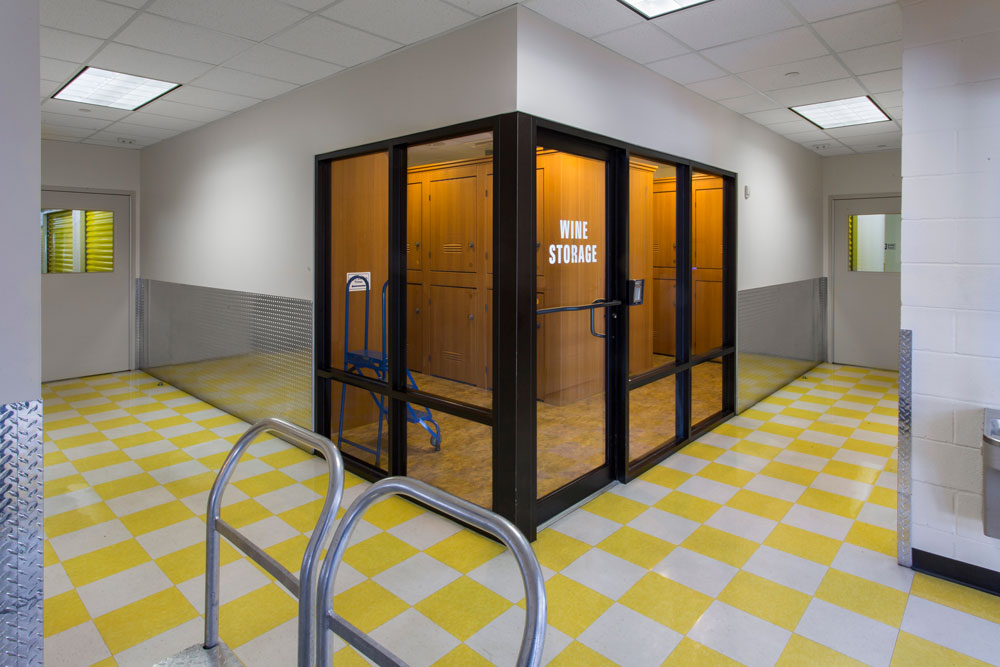
Special Storage Units Types – Amenities for Hobbyists
Another significant factor when considering different types of storage units is whether or not you are housing specialty items.
For instance, private wine collectors or restaurants often need someplace to keep their wines until they sell them or pull them out for celebration. If you don’t have a fancy French cave on hand, dedicated, climate-controlled wine storage is just the thing for you.
Whether or not you’re in the wine industry per se, storage units often pair beautifully with commercial ventures. Commercial storage units for small businesses offer room for extra inventory, climate-controlled warehousing and even delivery services.
Returning to the DeLorean, you’ll find space for that too in self storage. Choose between covered outdoor parking or, if you’re really afraid someone’s going to steal that gull-wing door, an indoor space for your vehicle. Get all the details on how to store a car properly in a storage unit here.
The Last Step: Choosing the Right Storage Unit Size
In addition to choosing the right kind of storage unit, you need to size it right as well. Typically, you’ll want to choose a storage unit that’s a little bigger than you think you need. That way, if you miscalculate or add to your possessions over time, you won’t run into space issues.
Storage Units come in a range of sizes such as:
If you’re storing vehicles or hobby items, make sure to choose a unit that can accommodate all the necessary accessories as well. Need more help? Here’s a quick guide to finding the right size storage unit for you.
So now that you have a handle on some of the options, how on Earth are you to choose?
Enter … the flowchart.
Flowchart: How to Choose the Right Type of Storage Unit
Feeling lost in the weeds? You won’t be for long! Choose your own adventure below and be on your way to the right storage fit for your needs.
Need More Help Choosing Between the Different Types of Storage Units?
Life Storage’s Customer Care Team is your go-to resource if you’re still not sure what type unit you need. Our expert sales team will ask all the right questions to help you arrive at the correct decision. They can add in a layer of knowledge about the specific facilities near you as well, in case there are any additional access types available to you. We can be reached at 1-844-LIFESTOR. Call today!
One last piece of advice: this might feel like a lot of information, but don’t freak out. Most quality storage places offer various unit sizes and are flexible when you need to move to a larger one.
Similarly, if you end up needing a specialty unit or an additional space, an experienced storage company will be able to help you out on the double. For now, make your best guess or get in touch with us today.
See? Not so hard. Now you can come to the task armed with all the information needed to choose the right storage unit for you. Search online for self storage available today!

